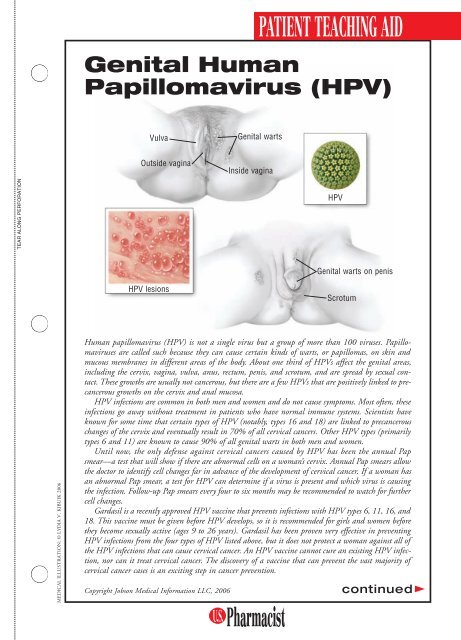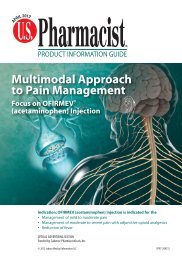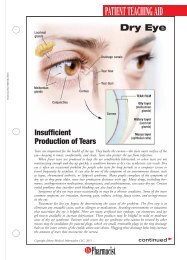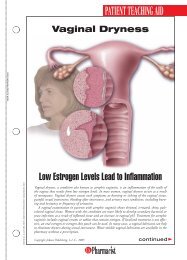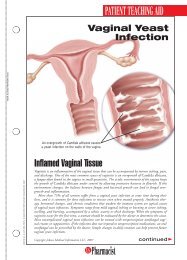Genital Human Papillomavirus (HPV) - US Pharmacist
Genital Human Papillomavirus (HPV) - US Pharmacist
Genital Human Papillomavirus (HPV) - US Pharmacist
Create successful ePaper yourself
Turn your PDF publications into a flip-book with our unique Google optimized e-Paper software.
PATIENT TEACHING AID<br />
<strong>Genital</strong> <strong>Human</strong><br />
<strong>Papillomavirus</strong> (<strong>HPV</strong>)<br />
Vulva<br />
<strong>Genital</strong> warts<br />
Outside vagina<br />
Inside vagina<br />
TEAR ALONG PERFORATION<br />
<strong>HPV</strong><br />
<strong>Genital</strong> warts on penis<br />
<strong>HPV</strong> lesions<br />
Scrotum<br />
MEDICAL ILL<strong>US</strong>TRATION: © LYDIA V. KIBUIK 2006<br />
<strong>Human</strong> papillomavirus (<strong>HPV</strong>) is not a single virus but a group of more than 100 viruses. <strong>Papillomavirus</strong>es<br />
are called such because they can cause certain kinds of warts, or papillomas, on skin and<br />
mucous membranes in different areas of the body. About one third of <strong>HPV</strong>s affect the genital areas,<br />
including the cervix, vagina, vulva, anus, rectum, penis, and scrotum, and are spread by sexual contact.<br />
These growths are usually not cancerous, but there are a few <strong>HPV</strong>s that are positively linked to precancerous<br />
growths on the cervix and anal mucosa.<br />
<strong>HPV</strong> infections are common in both men and women and do not cause symptoms. Most often, these<br />
infections go away without treatment in patients who have normal immune systems. Scientists have<br />
known for some time that certain types of <strong>HPV</strong> (notably, types 16 and 18) are linked to precancerous<br />
changes of the cervix and eventually result in 70% of all cervical cancers. Other <strong>HPV</strong> types (primarily<br />
types 6 and 11) are known to cause 90% of all genital warts in both men and women.<br />
Until now, the only defense against cervical cancers caused by <strong>HPV</strong> has been the annual Pap<br />
smear—a test that will show if there are abnormal cells on a woman’s cervix. Annual Pap smears allow<br />
the doctor to identify cell changes far in advance of the development of cervical cancer. If a woman has<br />
an abnormal Pap smear, a test for <strong>HPV</strong> can determine if a virus is present and which virus is causing<br />
the infection. Follow-up Pap smears every four to six months may be recommended to watch for further<br />
cell changes.<br />
Gardasil is a recently approved <strong>HPV</strong> vaccine that prevents infections with <strong>HPV</strong> types 6, 11, 16, and<br />
18. This vaccine must be given before <strong>HPV</strong> develops, so it is recommended for girls and women before<br />
they become sexually active (ages 9 to 26 years). Gardasil has been proven very effective in preventing<br />
<strong>HPV</strong> infections from the four types of <strong>HPV</strong> listed above, but it does not protect a woman against all of<br />
the <strong>HPV</strong> infections that can cause cervical cancer. An <strong>HPV</strong> vaccine cannot cure an existing <strong>HPV</strong> infection,<br />
nor can it treat cervical cancer. The discovery of a vaccine that can prevent the vast majority of<br />
cervical cancer cases is an exciting step in cancer prevention.<br />
Copyright Jobson Medical Information LLC, 2006<br />
continued
PATIENT TEACHING AID<br />
<strong>Genital</strong> warts are caused by some<br />
strains of the human papillomavirus<br />
(<strong>HPV</strong>). To protect against<br />
cervical cancer, girls and women<br />
should receive the <strong>HPV</strong> vaccine<br />
before becoming sexually active.<br />
A Preventable<br />
and Treatable Virus<br />
There are approximately six million people in the United States each year who develop a genital<br />
<strong>HPV</strong> infection, but most of these infections will disappear within a year or two without<br />
treatment. Sometimes, an <strong>HPV</strong> infection of the cervix will linger for a longer period of time<br />
and may (or may not) lead to precancerous changes in the mucosal tissue cells of the cervix.<br />
<strong>HPV</strong> infections have also been related to vulvar and vaginal cancers, anal cancer, cancer of the<br />
penis, and other cancers of mucosal tissues in the mouth and throat. It is estimated that nearly<br />
500,000 women around the world will be diagnosed with cervical cancer this year; of those,<br />
10,000 cases will affect American women. Close to 50% of these cancer cases will be fatal.<br />
Detection: The <strong>HPV</strong> infections most likely to cause precancerous and cancerous changes in<br />
the mucosal cells are difficult to detect because they do not cause symptoms. In women, an<br />
annual Pap smear can detect cervical cell changes considered to be precancerous, but for men,<br />
there is no similar test available to detect early-stage, <strong>HPV</strong>-related cancers such as anal cancer.<br />
In men—and women—who have anal sex, anal cancer is becoming more common, and a test<br />
similar to the Pap smear is in the early stages of development.<br />
<strong>Genital</strong> Warts: Although both men and women can develop genital warts, the <strong>HPV</strong> viruses<br />
that cause these warts are considered to be at low risk of progression to precancerous and cancerous<br />
tumors. However, to avoid spreading <strong>HPV</strong>, genital warts that are apparent should be<br />
treated before continuing sexual activity.<br />
New <strong>HPV</strong> Vaccine: Currently, the <strong>HPV</strong> vaccine is approved for use in girls and young women<br />
ages 9 to 26. It is most effective when given before a female is sexually active. It is administered<br />
in three doses—one every six months—over a 12-month period. At this time, the vaccine<br />
is known to provide protection from its target <strong>HPV</strong> viruses for at least a four-year period.<br />
Research is being done to determine how long immunity will last and whether a booster shot<br />
of the vaccine will be required later in life. Although the vaccine was studied in boys and was<br />
found to be safe, it is not yet known whether it will work to prevent genital warts or anal or<br />
penile cancers. The <strong>HPV</strong> vaccine was tested in thousands of people prior to its approval, and<br />
it was found to be both safe and effective. Side effects of the vaccine are mild tenderness in the<br />
area of injection.<br />
Women should continue to have annual Pap smears to look for precancerous changes in the<br />
cervix, even if they have received the new <strong>HPV</strong> vaccine. The risk of sexually transmitted <strong>HPV</strong> infections<br />
can be somewhat reduced by using a condom, but condoms are not 100% effective, since<br />
they do not cover the entire genital area. Changes in cervical or anal mucosal cells should be<br />
closely monitored by a physician to determine the appropriate treatment to avoid future cancers.


